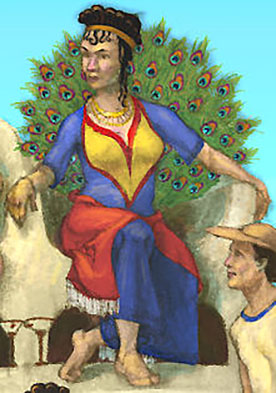
|
Hera (HEE-ruh; Roman name Juno) was the goddess of marriage. Hera was the wife of Zeus and Queen of the Olympians.
Hera hated the great hero Heracles since he was the son of her husband Zeus and a mortal woman. When he was still an infant, she sent snakes to attack him in his crib. Later she stirred up the Amazons against him when he was on one of his quests.
On the other hand, Hera aided the hero Jason, who would never have retrieved the Golden Fleece without her sponsorship.
In Greek mythology, Hera was the reigning female goddess of Olympus because she was Zeus's wife. But her worship is actually far older than that of her husband. It goes back to a time when the creative force we call "God" was conceived of as a woman. The Goddess took many forms, among them that of a bird.
Hera was worshipped throughout Greece, and the oldest and most important temples were consecrated to her. Her subjugation to Zeus and depiction as a jealous shrew are mythological reflections of one of the most profound changes ever in human spirituality.
Tens of thousands of years ago, as the evidence of cave art and artifacts makes clear, humanity was focused on the female body, either pregnant or fit to bear children. Childbirth was the closest humans came to the great power that caused the earth to bring forth new life in the spring. To the extent that these distant ancestors of ours were evolved enough to think of worshipping this power, we may safely conclude that they thought of it as female.
Thousands of years later (and some five to nine thousand years before our own time), the European descendants of these people lived in large villages, with specialized crafts and religious institutions. It is clear from the artifacts they left behind that they worshipped a power (or a group of powers) that came in many forms--a bird, a snake, perhaps the earth itself. And this great power was female. For the human female has the ability to procreate--to bring forth new life.
It is said that it was only when humanity discovered man's role in procreation that male gods began to be worshipped. There is no reason to doubt, though, that male gods were worshipped before the mystery of birth was fully known. In all probability the greatest powers were thought of as female but there were male deities as well. And it is clear that even after procreation was properly understood, the more peaceful Europeans--perhaps down to the "Minoans" of Crete--continued to worship the Great Mother.
And there were many peaceful Europeans. Many of the largest villages of that distant era were unfortified. The culture known as "Old European" did not fear aggression from its neighbors. But then things changed and a great period of violence began. Invaders swept into Europe from the vast central plains of Asia. They brought the Indo-European language family that today includes French, Italian, Spanish and English. They also brought a sky god, the supreme male deity that in Greek mythology became known as Zeus.
Little is known of these early Indo-Europeans, but the peaceful settlements of Old Europe were no match for them. In some places their new culture became supreme, in others there was merger. Hardier mountain folk resisted, though many were displaced from their strongholds, moved on and displaced others in a domino effect. The Dorian invasion of Mycenaean Greece can be seen as a result of this chain reaction.
The old order seems to have held out longest on Crete where, protected by the Aegean Sea from invasion by land, the high Minoan civilization survived until almost three thousand years ago. Abruptly, then, from the perspective of human existence, the gender of the greatest power changed from female to male. And many of the stories that form the basis of Greek mythology were first told in their present form not long after the shift.
Zeus's many adulterous affairs may derive from ceremonies in which the new sky god "married" various local embodiments of the Great Goddess. That there was some insecurity on the part of the supplanter god and his worshippers is seen in the mythological birth of Athena from Zeus's head--as if to say that the sky god could do anything any Great Goddess could do.
This Goddess continued to be worshipped in some form down into historical times. Her worship is sometimes dismissed as a "fertility cult", largely because religious practices degenerated under new influences. But we may look for traces in the myths of the old order, in which Athena, whose name is pre-Greek, was the Goddess herself.
Under the influence of the Indo-Europeans, this bird goddess became the chief deity of war. Her earlier guise may be glimpsed in Athena's symbol, the owl, which derives from the preceding thousands of years of sacred bird imagery.
|




